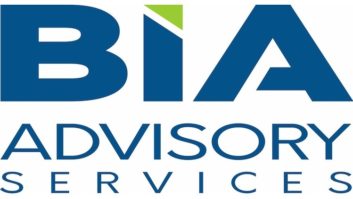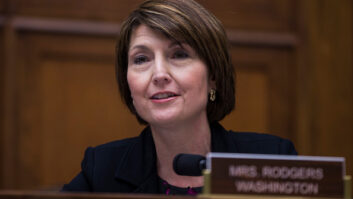As I have mentioned elsewhere, we�re carrying a theme throughout this month�s issue � that of non-traditional broadcast technologies.
Usually we write about the evolution of technology utilized in content generation or in transmission, but this time around, we�re going to talk about an evolutionary change in technology used in the generation of revenue�very important to those of us that work in commercial radio. (Readers working in non-com radio should find this interesting as well.)
�Programmatic� is a relatively new term used to describe the technology that allows buyers and sellers to engage in transactions via the programming, or automation, of sophisticated algorithms in a marketplace or exchange.
The RadioSpot Ad Server is installed at the radio station and configured in a secure network.

Advertisers and their agencies have said they would like to enable programmatic trading across all of their media buys, representing as much as 50 percent of all media spending. Few of these dollars have come to radio yet, but supporters say automated buying and selling can return money to radio that has migrated to digital advertising, which advertisers find easier to transact. They�re also saying that programmatic technology leads to a greater return on investment for advertisers and agencies, while optimizing the rates media get for their inventory.
JELLI
One of the promoters of programmatic ad technology is San Mateo, Calif.-based Jelli, founded in 2008 by a team with deep experience in Web, media and software innovation.
CEO and co-founder Mike Dougherty is a former Microsoft executive. Jelli�s other co-founder, Jateen Parekh, was the first employee of Amazon�s Lab126 in 2004, where he became the head of advanced technology and platforms for the Kindle project. Parekh was also an early engineer and architect at ReplayTV, which launched the first digital video recorder.
There are two kinds of RadioDash: One for advertisers and agencies to track campaigns, and another for affiliate stations. Jelli recently raised $21 million in Series B financing. Investors in the round included Relay Ventures, Intel Capital, First Round Capital, iHeartMedia and Universal Music Group. This funding brings the total amount raised to $37.6 million.

The company also recently announced it has been enlisted by iHeartMedia to provide the technology platform that will allow advertisers to purchases ads, in a programmatic manner, on all of its 850 radio stations. Jelli will also provide the technology behind a new programmatic buying exchange for Katz Media.
I recently interviewed Jateen Parekh to discover more about the technical aspects of the system.
Doug Irwin:It�s my understanding that ad buyers will use an online portal to make ad buys, based on the desired demographic, day-part and cost-per-thousand.
Jateen Parekh: Initially, ad buyers will still go through their normal sales channels. However, the sales and ad operations teams use SpotPlan, which is a Web application that interfaces with Jelli�s cloud-based platform. Planners enter in the goals of the advertisers� campaign, including demographic, day-part and campaign measurement goals (not just CPMs). Jelli�s goal is to make buying linear radio as easy and fast as possible. Some ad planners just want to enter high-level goals, and then allow the Cloud Platform to do the rest. Eventually, we will also provide a version of this platform directly to ad buyers to use on a self-service basis to buy inventory directly, but that will be in a future release.
DI:The actual spot audio is uploaded to the Jelli system via an online UI also, correct?
JP: That is correct. Before a campaign is scheduled to start, audio creative is securely uploaded into the platform and automatically rendered for length, levels, audio quality and broadcast suitability. The agency and the network manager review and approve creative prior to the campaign start.
DI:Ads are transferred to their respective radio station from Jelli servers via �the cloud.� Tell me a little bit about how that is accomplished.
JP: The RadioSpot Ad Server is installed at the radio station and configured in a secure network, and only makes outbound calls to the Jelli Cloud Platform using a secure application programming interface. Once properly authenticated, the appliance downloads a playlist containing the spots to air. If ad spots have not been previously downloaded, or are new, the appliance makes secure connections to the Cloud Platform to download any missing audio creative.
DI:Regarding spot playback: When the spots come up in the commercial log, the Jelli server plays them out, without further intervention.
JP: Yes � every station traffic manager has the ability to schedule �Jelli breaks� into their existing traffic system. When the break is encountered by the local automation system, it triggers the RadioSpot Ad Server to fill the break. All modern automation systems work similarly to NexGen, where the trigger mechanism is a TCP-based message. RCS Zetta, WideOrbit Automation for Radio, AudioVault FLEX, STORQ, iMediaTouch fall into that category. However, we also work alongside another 25 other systems�[including multiple versions of some systems], including Maestro, Scott Studios 32 [SS32], and RCS MasterControl and older versions of AudioVault that don�t support TCP-based messages.
For that reason, we developed a proprietary audio trigger technology that does not require any automation system configuration, networking or interruption to playback. The automation triggering is pretty cool for traffic because you can now just place the dedicated breaks in your logs and without having to deal with changing creative, affidavits, rotations, etc., because the RadioSpot Ad Platform manages all of it automatically and in real time.
Sales and ad operations make use of a special UI called SpotPlan to create proposals and place orders.DI:After the Jelli server confirms the spot played, it generates an appropriate affidavit, as a final step.

JP: That is correct. The Jelli Ad Server records all breaks and automatically detects whether ads have played properly and reports all plays that can be viewed [or listened to] by ad buyers or advertisers, on a self-service basis. Jelli�s reporting Web application used by advertisers is called RadioDash, which is also available to sales and local traffic managers who want visibility into RadioSpot performance. Essentially, RadioDash real-time reporting eliminates the needs for affidavits.
DI:Do ad buyers make use of a special UI, or do they access the system using the public Internet?
JP: Sales and ad operations make use of a special UI called SpotPlan to create proposals and place orders. SpotPlan is used by sales teams to look into available inventory, setup campaign goals, create proposals and handle insertion orders. Once spots air on stations, RadioSpot reports the data back to the Jelli Cloud Platform, which is then displayed in RadioDash.
We have two flavors of RadioDash: One for agencies and advertisers to track all of their advertiser�s campaign goals across all markets, and another one for affiliate stations who want visibility into what ran on their particular station or market.
DI:Where is the Jelli system located? Is it a cloud service supported by something like Amazon Web Service or does it have its own data center(s)?
JP: It is a hosted cloud service that does not rely on Jelli�s own data center. All of Jelli�s programmatic systems are handled, and hosted, by AWS, allowing us to easily scale up without having to manage and operate a local datacenter. Jelli uses AWS for computing [EC2], storage [S3], and content delivery [CloudFront]. Our platform runs out of AWS, and is accessed by our Web applications using Jelli developed APIs.
It�s long been said that radio�s slice of the advertising pie is not as large as it should be, based on measured audience size and return on investment. In order to remain in the same league as the other big media, radio has to avail itself to advertisers in the same manner as they do. Programmatic buying represents a further evolution of the commercial radio business model, and I, for one, am hoping that our slice gets bigger because of it.
�
�









